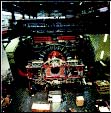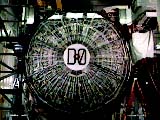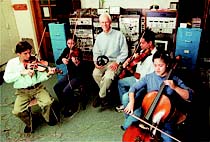
Vol. 1 No. 2 Fall 1999
Raymond L. Brock. . . Chairperson,
Department of Physics and Astronomy
Wolfgang W. Bauer . . Associate Chairperson for Undergraduate
Instruction
Phillip M. Duxbury . . . . . . Associate Chairperson for Graduate
Instruction
Bernard G. Pope. . . . . . . . . . . . . . . . Associate Chairperson
for Operations
Eugene J. Kales. . . . . . . . . . . . . . . . . . . . . . .
Newsletter Production Editor
In and Around the Department
The 1999 entering class for our physics and astronomy graduate
program was one of our strongest ever, with a total of 25 students
joining our program at the beginning of Fall semester and 2 at the
beginning of Spring semester. We had a nice mix of US and foreign
students, with about 50% being in each catagory. One student was
awarded a College of Natural Science fellowship, while two students
received fellowships from the NSCL. We now have an active graduate
recruiting committee and continue to look for ways to find and
attract high quality physics and astronomy students.
Each year the Department of Physics and Astronomy honors
excellence in faculty, staff, graduate and undergraduate students
with various awards. Departmental Awards for academic year 1998-99:
Thomas H. Osgood Undergraduate Award (for Outstanding Senior) to
Michelle Stark; Bruce Ver West Award (for Outstanding Junior) to be
shared by Timothy McCaskey, Adam Smith, and Jeroen Thompson; Favorite
Graduate TA (vote of GTA Supervisors) to John Brecht; Sherwood K.
Haynes Graduate Award (for Outstanding Graduate Student) to John
Kruse; Best Graduate Teacher (vote of Graduate Students) to Mark
Dykman; Outreach Award to Gary Westfall for his involvement in local
school programs such as LEAP and Science Olympiad; Distinguished
Staff Award to Janet King; Thomas H. Osgood Teaching (Non-Tenured)
(for undergraduate teaching) to Scott Pratt; Thomas H. Osgood
Teaching Award (Tenured) (for undergraduate teaching) to William
Pratt; Thomas Kaplan Award (for Outstanding CMP "brown-bag" seminar)
to be shared by Tatyana Barabash and Yen-Sheng Su.
Jazcek Braden, a Computer Assistant for the Department of Physics
and Astronomy for over two years, has received honorable mention as
Student Employee of the Year at Michigan State University.
David Tomanek has received an offer to visit Tokyo Institute of
Technology as a visiting professor during the Spring semester of
2000, all expenses paid.
Diane Clark retired July 7 after 29 years of service in the
Physics-Astronomy Library and 32 years total service to the MSU
Libraries. In August, Virginia Boone joined the Department as the new
Library Clerk. She comes to us
with over ten years experience working in the Main Library.
Ed Kashy and Michael Thoennessen as well as their colleagues,
Nancy Davis, Sherri Wolfe, and Isaac Tsai have been notified that
they are the recipients of the 1999 Wickenden Award of the American
Society of Engineering Education. This award recognizes the paper
published in the Journal of Engineering Education each year that is
most responsive to the goals and objectives embodied in the Editorial
Board's Editorial Policy. Their paper, "Using Networked Tools to
Promote Student Learning in Large Classes" was published October 1998
issue of that Journal.
Susan Simkin has accepted a two-year appointment at the NSF within
the Division of Astrophysics as Program Director for Extragalactic
Astronomy and Cosmology, effective 13 September 1999. She can be
reached after September 13 at ssimkin@nsf.gov or by telephone at
(703) 306-1827.
When Jerry Cowen passed away earlier this year he expressed the
wish that there should be no conventional memorial function for him.
His wife, Elaine, wished us to honor that request. Many in the
department, and elsewhere, missed the opportunity to remember Jerry.
Three people (Bhanu Mahanti, Tom Kaplan and Peter Schroeder)
discussed the possibility of a conference to recognize Jerry's
contributions to the teaching and research of Physics. Elaine
accepted the idea provided it was "rooted in Physics", and in this
way the Jerry Cowen Symposium was born. Invitations were sent out to
as many of Jerry's old students and research colleagues that we could
locate. (Our apologies to those we missed.) The response was so great
that there was only five minutes for Dr. Repko of the present faculty
to speak. The guest speakers were: Dr. Robert Spence, Jerry's Ph.D
supervisor; Dr. Philip Wigen, Ohio State University, Jerry's first
Ph.D student; Dr. Frederick Jeffers, Iomega, an undergraduate in
Jerry's research laboratory in 1959(!); Dr. Mercouri Kanadzitas,
Chemistry Dept. MSU; Dr. Jan Hessler, Argonne National Laboratory;
Dr. Diandre Leslie Pelecky, University of Nebraska; Dr. Gregory
Kenning, University Of California at Riverside; Dr. Michael Wilson,
Tulsa University; Dr. Phillippe Monod, Ecole Normale Superieure,
Paris; Dr. Isabelle Krauss, University of Strasbourg, France (whose
visit was cancelled at the last moment for family reasons). The
speakers were remarkable in keeping within the boundary condition
"rooted in Physics." There ensued several lively discussions in which
we dare to believe Jerry would have enjoyed participation.

|
|
Wilson Hall at Fermilab
|
MSU at Fermilab
Bernard Pope
A striking feature of the research carried out by the experimental
High Energy Physics group is that it is often based in locations away
from the campus of Michigan State. A significant program of research
over the past 15 years has been participating in the collider program
at the Fermi National Accelerator Laboratory (Fermilab) in Batavia,
Illinois &endash; about 40 miles west of downtown Chicago.
The particles produced in these violent collisions are analyzed by
two massive detectors, named CDF and DZero, located at interaction
points separated by just over a mile around the circumference of the
accelerator ring. Each detector has been built and operated by a
collaboration of about 500 physicists. MSU is almost unique in having
significant participation in both of these collaborations and is, in
fact, one of the lar gest university groups involved at Fermilab.
Professor Joey Huston is the leader of quantum chromodynamics (QCD)
studies in the CDF experiment, while Professor Harry Weerts is a
Spokesperson and Project Manager of the DZero collaboration.

|
|
The CDF Detector
|
After an extremely successful data-taking run from 1993-96, the
Fermilab Tevatron collider and both detectors are presently being
upgraded with a significant improvement in luminosity expected.
Perhaps the most important physics result from the last Tevatron run
has been the discovery of the long-sought top quark and the
measurement of its mass. The top quark's extremely large mass (175
GeV) has stimulated intense discussion on the nature of mass itself
and prompted renewed searches for the postulated Higgs boson, the
generator of mass. Precision electroweak measurements from both DZero
and CDF on the mass of the W boson have, in turn, constrained the
mass of the Higgs to surprisingly low values. This gives some hope
that the Higgs may be accessible by the increased luminosity and
energy of future Tevatron running.
|

|
|
The DZero Detector
|
During the present shutdown of the Fermilab accelerator facilities,
design and construction of detector upgrades are being carried out at
MSU. For example, to cope with the expected higher luminosities the
MSU DZero group has been charged with the responsibility of
redesigning the fast trigger system. The work is being done in our
electronics shop supervised by Dan Edmunds with specific
responsibility for upgrades to the Level 1 trigger assigned to
Professor Maris Abolins and for the Level 2 trigger to Professor Jim
Linnemann.
The Tevatron collider is scheduled to recommence running around
the end of next year. We anticipate that all members of the MSU high
energy group will once again play substantial roles in running the
two experiments. Our physics interests will be focused on the
properties of the top quark, on electroweak phenomena, on QCD, and on
searches for the Higgs particles and any possible new physics beyond
the Standard Model.
The Sound of Music
|

|
|
Dr. William Hartmann, center, with a string quartet
wired for a new recording technique. From left are Takeshi
Abo, first violin; Karel Taulbee, second violin; Jan Wea
Yoo, viola; and Mary Williams, cello.
|
In a talk presented at the 2 November 1999 meeting of the Acoustical
Society of America in Columbus, OH, William Hartmann described and
demonstrated a new method of sound recording and reproduction called
"Local Performance Recording/Reproduction (LPR/R)." In his
demonstration, he applied the technique to a Mozart string quartet.
In a fundamental departure from traditional multichannel recording
techniques, Hartmann isolated each instrument on its own two channels
of an eight-channel digital recorder using two contact transducers
per instrument. He then experimented with different mixes of the two
channels and different speaker configurations for each instrument.
With speaker radiation patterns similar to the particular violin,
viola, or cello, and placements arranged as the musicians originally
sat, the result sounds as if a live quartet were playingthe room
acoustics were those of the listening environment and not those of
the recording environment.
The LPR/R technique requires a minimum of one recorded channel and
one transducer in the listening environment for each source in the
ensemble. Application to string quartets is a natural since
technically it works well, there is a vast and wonderful literature
for string quartets, and there are many performers and devoted fans
of string quartets. Conventional two-channel distribution of sound,
via stereo broadcasting or compact discs or tape, is inadequate for
LPR/R. The LPR/R technique depends on new technology (not far off)
for multichannel distribution.
This talk was reported in the New York Times on November 16
and the article is available at website nytimes.com in the technology
archive free article section as "A New Dimension in Recorded Music"
by James Glanz. The November issue of Physics Today includes a
related article by Hartmann on the localization of sound by human
listeners.
You can learn more about Bill's research at http://www.pa.msu.edu/acoustics/
Alumni News
Julius Kovacs
Occasionally we are pleasantly surprised by visits from former
undergraduate and graduate students who are passing though East
Lansing, but more often we receive email messages from alumni who
want to let us know what is going on with their careers and their
lives. A random selection of these bits of news appears below. If
you'd like to share some information for the next newsletter we'd be
happy to include it.
Cathy Mader PhD'93 was recently awarded tenure at Hope
College. She is active with the CAPA program at Hope, maintaining the
system for the College's users and recently participated in a CAPA
workshop at MSU, describing how Hope's program works and is similar
to or different from programs at other places (such as MSU). Mary
Lu Larsen PhD'76 is still at Towson in Maryland and has recently
made a change of research effort to particle astrophysics, in harmony
with an emphasis change in the college. David Musicant BS'92
has returned to the University of Wisconsin, Madison to work on his
PhD in Computer Science after receiving two MSs from UW (in
Mathematics and Computer Scince) in 1994. He spent three years in the
consulting industry before returning to UW. Dennis Kuhl PhD'96
has joined the faculty as an Assistant Professor in Physics at
Bridgewater State College in Massachusetts after completing
postdoctoral work in the Center for Science and Mathematics Teaching
at Tufts University. Shigeru Yokoyama PhD'96 is a Lecturer in
the Physics Department at the University of Michigan, after two years
in medical physics in Houston. Michael Fauerbach PhD'97
informs us that he has completed a postdoctoral appointment at
Florida State University and joined the physics faculty at the
Mississippi School for Mathematics and Science, one of only four
public residential high schools in the country. Only the best of 11th
and 12th graders in the state of Mississippi are awarded scholarships
to attend MSMS. Bruce Wood BS'86 and MS'89 is at Lockheed
Martin in Palmdale, CA after several years on the east coast working
with the project attempting to update the antiquated air traffic
control system with one that will be more reliable. That project has
been put on indefinite hold. Raman Pfaff PhD'96 is at the
University of New Haven with a joint appointment in Physics and
Education Departments. Teaching five courses keeps him busy.
Michael Narlock MS'94 is currently the planetarium operations
manager and staff astronomer at Cranbrook Institute of Science with
an adunct faculty position at Lawrence Technological University.
Lowell McCann PhD'98 joined the physics faculty at the
University of Wisconsin, River Falls (his alma mater) this fall after
completing a year's postdoc at MSU after completion of his degree.
Stephen Tanner BS'94 completed his PhD in mathematics at the
University of Washington. He has begun a postdoctoral position at the
University of Minnesota. Ian Redmount BS'78 has been awarded
tenure and promoted to Associate Professor at Park College of St.
Louis University. Jaeyong Yee PhD'95 has accepted a teaching
position at Eulji University where he will be teaching
interdisciplinary physics/medicine. He and Hyunju Chang PhD'95
recently announced the birth of their second daughter. John
Mountz PhD'74 is Professor of Medicine in the Division of
Clinical Immunology and Rheumatology, Department of Medicine at the
University of Alabama at Birmingham. James Mountz PhD'74
likewise has an MD degree and is at the the University of Alabama in
Birmingham. John Ruscigno MS'77 is with the Oregon Department
of Environmental Quality; he has worked on noise control, air quality
and is now involved with lobbying. Michael Miller BS'99 is in
the graduate program in physics at Yale University. Jerry
Johnston BS'62 MS'65 PhD'67 has been a Program Manager at Optical
Coating Laboratory in Santa Rosa, CA since 1982. He has managed the
coating of large mirrors such as for the Chandra x-ray telescope that
was launched by NASA in July. He is currently managing projects for
development and manufacture of passive optical components for fiber
optics telecommunications applications.
Let us know about you and we will include your news in the next PA
News. Do you want to find a lost classmate? Use our web site to
inquire.
http://www.pa.msu.edu/alumni.htm
email: newsletter@pa.msu.edu